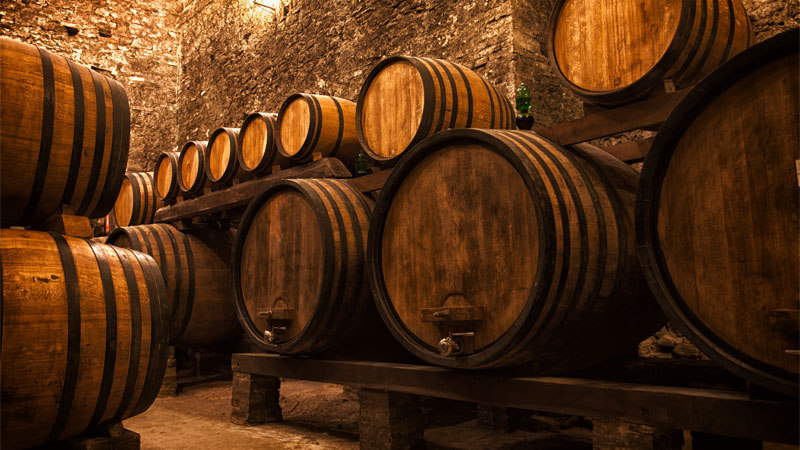When you get serious about wine, the first thing you learn to hate is the taste of new oak. It’s a childish taste, haughty sommeliers sniff, and only unsophisticated people like it.
This is a relatively new mandate. In the bad old days of the 1990s and early noughties, when American critics held immense sway over collectors’ tastes and wallets, new oak plus super-ripe fruit were paramount for red wines. Oak was a critical component of the sweet, rich style of top California Chardonnays during this period, too.
Nowadays, trend-setting somms hate those oaky, ripe wines, and the hippest winemakers avoid new oak barrels studiously. If the latter do go near them, they might choose vessels made of older oak that impart very little or no flavor. Or, they find other ways of aging wine: massive barrels called foudres, fuders, or botti, which span 1,000 to 5,000 liters in size; concrete tanks and eggs; terracotta (amphorae, tinajas, or qvevri, depending on their shape and where they come from); and, lately, ceramic spheres. Sometimes, though not often, they use stainless steel.
In some ways, this is a necessary correction. We don’t want our wines tasting too much like wood because, even though some people enjoy that flavor, it gets in the way of terroir. What’s the point in choosing a good vineyard site and working hard to produce good grapes only to iron out the character of the wine by blasting it with new oak?
But, as with any trend in wine – even a correcting one – the pendulum often swings too far. Just because over-oaking is a problem, it doesn’t mean that all oak is bad. Small oak barrels, including new ones, have a role in forming fine wines.
Oak can never truly be “over.” We simply need to be smarter about how we use, think, and talk about it.

Using oak to intentionally impart flavor is a relatively recent development. Originally, winemakers used barrels because they could capably store liquids in an age when stainless steel tanks and plastic didn’t exist. Barrels were practically unbreakable, more robust than terracotta amphorae and much easier to transport.
To make a barrel, you split the wood into thin planks called staves, which are seasoned for two or three years, usually outdoors. Then, you cut them precisely into shape, and assemble them into a barrel with the help of some metal hoops. At this point, you heat your half-constructed barrel over a fire. This makes the staves flexible enough to bend into shape, and subtly chars the wood that will become the barrel’s interior.
The flame-broiled effect, called “toast,” enormously impacts how these barrels affect flavor. (In fact, some winemakers use steam to adjust their staves, so as to avoid “toast.”) Whomever is purchasing this barrel can specify the degree of toast they prefer.
In the 1970s and ‘80s, winemakers realized barrels’ shape, type of oak used, and manner of construction could influence the taste and structure of wine. (Wine barrels are almost always made of oak. Variants composed of chestnut, acacia, or cherry wood exist but are rare.)
By the 1990s, the wine world cottoned to the fact that brand-new barrels add quite a lot of flavor; and, in conjunction with picking grapes super ripe, new barrels can produce sweetly fruited wines with spicy oak. This proved to be a winning combination, quickly seducing the palates of inexperienced wine drinkers.
The major flavor compound wine picks up from new oak is called oak lactone, which smells of coconut and vanilla. (Interestingly, barrels made with American oak impart more flavor because this type of wood has much more lactone in it.) Guaiacol, which smells quite smoky, is another property found in wood. It increases in tandem with higher levels of toasting.
Other properties found in wood include vanillin and furfural, which gives sweet, caramel, and nutty notes. Wood also contains tannins, and these add structure and alter color.
One of the real benefits of barrel-aging is it exposes the wine to small amounts of oxygen in a way that stainless steel tanks cannot. Barrel-aging also means the wine is in steady contact with the dead yeast cells at the bottom of the barrel known as lees. This is especially important for white wines, which are fermented in the barrel, because all the yeast cells will end up at the bottom.
As the yeast cell walls begin to decompose, they release the contents of the cells. These can interact with the wine, adding texture and keeping it fresh by scavenging oxygen.
Because the skins are involved in making red wine, fermenting in a barrel is a bit awkward. The reds usually complete fermentation in an open container on the skins, and then the wine is pressed and put into the barrel for aging. This means the lees aren’t quite as important, because there will be fewer dead yeast cells at the bottom.
Still unconvinced that we need to hang onto our barrels? Consider Burgundy.
Even the hippest somms go weak-kneed over quality red and white Burgundy. They may be disenchanted by Bordeaux, but Burgundy is a place of wine pilgrimage, making terroir-focused wines that, at their best, are peerless examples of elegance and power.
And in every Burgundy cellar, especially those making top wines, you will almost exclusively see small oak barrels.
The best winemakers in Burgundy are skilled proponents of what is known as élevage, which roughly translates as the bringing up of a wine. It’s an incredible skill set, the stuff that truly excellent wines are made of. And barrels are the principal tool of élevage.
Winemakers in Burgundy typically leave reds in small oak barrels in their cellars over winter, and then, in spring, as the cellar warms, the wine within begins its second, malolactic fermentation. The wine then spends more time in barrel until it is stable and clear.
Burgundy’s best whites ferment in the barrel, and then there are decisions about how to manage the lees — to stir or not to stir? — and whether or not to transfer them from one barrel to another in a process called racking. Winemakers also have to determine how long to leave these white wines in barrel.
Whenever international winemakers attempt to make high-end versions of Burgundian wines like Pinot Noir and Chardonnay, they use small oak barrels. When you ferment wine in a new barrel, the chemical process can impart certain flavors. The results are much less traditionally “oak-flavored” than if you’d fermented Chardonnay in a steel tank and then transferred it to a barrel.
The contemporary backlash to oak isn’t wrong, it’s just incomplete. Hipster somms have fallen out of love with barrels because of the ways oak aging was ruthlessly abused in the pursuit of spoofy wines. But barrels do have a place in the creation of some of the classic wine styles that even the most discerning wine professionals and enthusiasts know and love.
I am thrilled to see more concrete, terracotta, and large oak in cellars, but I also understand that small oak has a place. In skilled hands it can help fashion amazing wines.
We are certainly allowed to hate excessive oaking, but oak itself isn’t the enemy. Ignorance and bad winemaking are worse for wine than any barrel.
